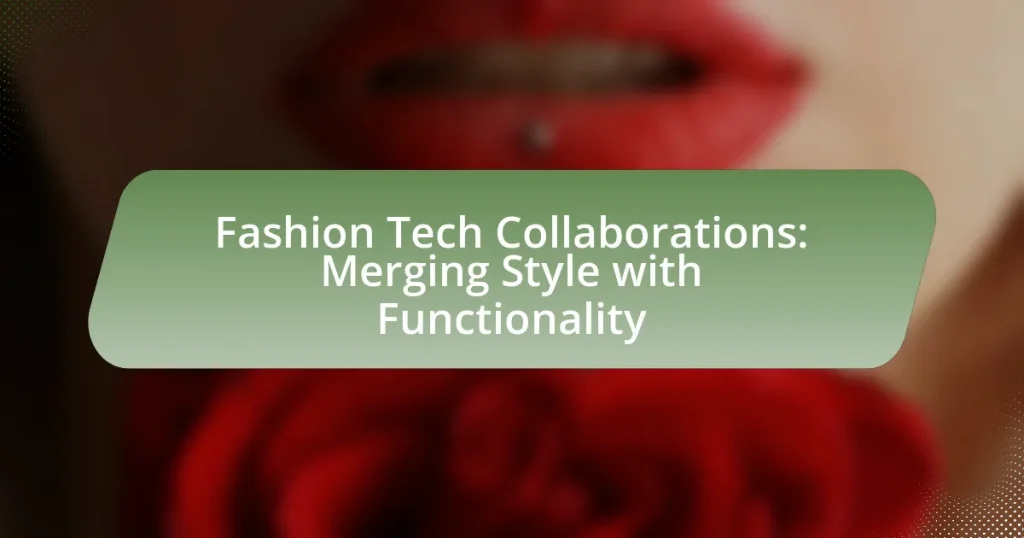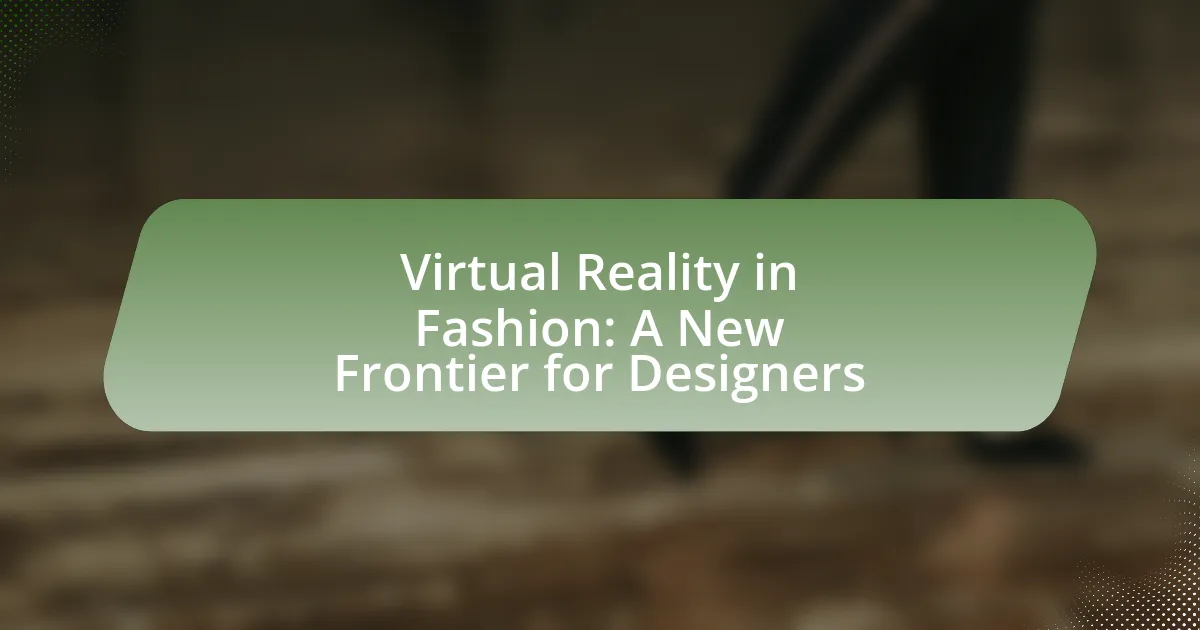Fashion tech collaborations represent partnerships between fashion brands and technology companies that aim to integrate innovative technology into clothing and accessories, enhancing functionality and user experience. These collaborations lead to the development of products such as smart textiles, wearable technology, and sustainable materials, addressing consumer demands for both style and practicality. Key elements for successful collaborations include clear communication, mutual respect, and complementary skills, while challenges such as technological integration and cultural differences can impact outcomes. The article explores notable examples, the influence of these partnerships on consumer behavior, and future trends in the fashion tech industry, emphasizing the importance of innovation and sustainability in shaping the market.
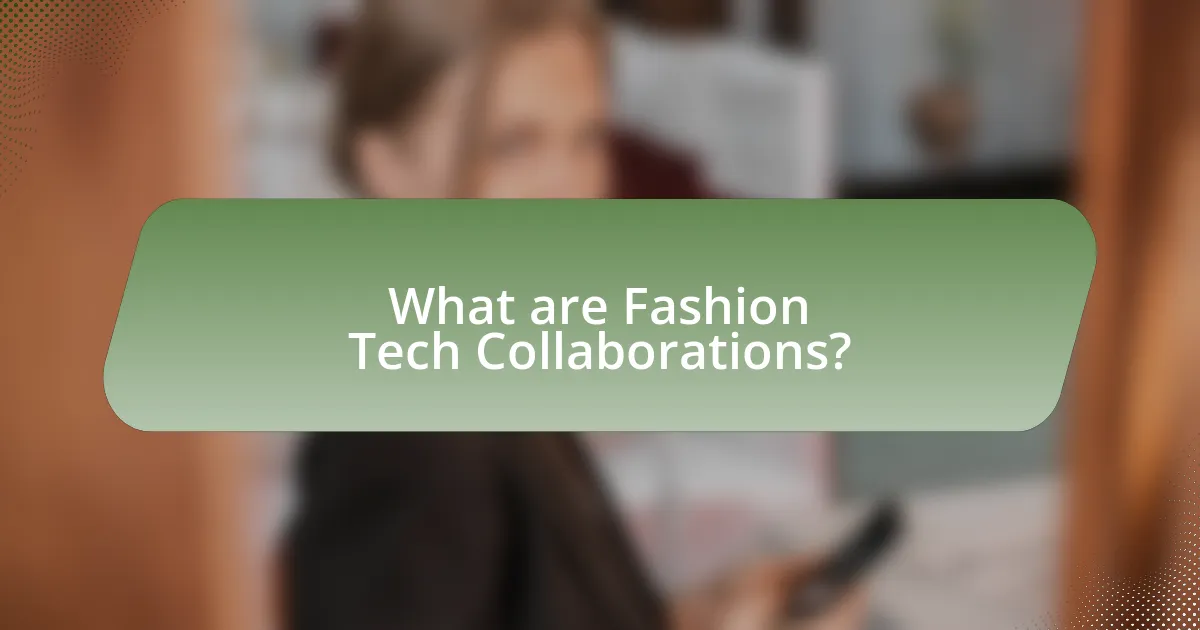
What are Fashion Tech Collaborations?
Fashion tech collaborations are partnerships between fashion brands and technology companies aimed at integrating innovative technology into clothing and accessories. These collaborations often result in products that enhance functionality, such as smart textiles that monitor health metrics or wearable devices that combine style with advanced features. For instance, the collaboration between Nike and Apple led to the development of the Nike+ system, which tracks fitness data through smart shoes and devices. Such partnerships exemplify how the fusion of fashion and technology can create new market opportunities and enhance consumer experiences.
How do Fashion Tech Collaborations redefine the industry?
Fashion tech collaborations redefine the industry by integrating advanced technology with traditional fashion design, enhancing functionality and user experience. These partnerships enable the creation of innovative products such as smart textiles, wearable technology, and sustainable materials, which address consumer demands for both style and practicality. For instance, collaborations like that of Adidas and Parley for the Oceans have led to the production of shoes made from recycled ocean plastic, showcasing a commitment to sustainability while maintaining aesthetic appeal. Such initiatives not only attract environmentally conscious consumers but also set new industry standards for responsible production practices.
What are the key elements of successful collaborations?
The key elements of successful collaborations include clear communication, mutual respect, shared goals, and complementary skills. Clear communication ensures that all parties understand their roles and responsibilities, which is essential for effective teamwork. Mutual respect fosters a positive working environment, allowing diverse perspectives to be valued and integrated. Shared goals align the efforts of collaborators, driving them toward a common outcome. Complementary skills enhance the collaboration by bringing together varied expertise, which is particularly important in fashion tech collaborations where merging style with functionality requires both creative and technical knowledge. These elements are supported by research indicating that successful partnerships often exhibit these characteristics, leading to innovative solutions and enhanced productivity.
How do these collaborations influence consumer behavior?
Collaborations between fashion and technology significantly influence consumer behavior by enhancing product appeal and functionality. These partnerships often lead to innovative designs that attract tech-savvy consumers who value both aesthetics and practicality. For instance, the collaboration between Adidas and Parley for the Oceans resulted in footwear made from recycled ocean plastic, appealing to environmentally conscious consumers and increasing brand loyalty. Research indicates that 66% of global consumers are willing to pay more for sustainable brands, demonstrating that such collaborations can drive purchasing decisions.
Why are Fashion Tech Collaborations important?
Fashion tech collaborations are important because they drive innovation by merging technology with fashion, enhancing both functionality and consumer experience. These partnerships enable the development of smart textiles, wearable technology, and sustainable practices that meet modern consumer demands. For instance, collaborations like that of Adidas and Parley for the Oceans have resulted in products made from recycled ocean plastic, showcasing how technology can address environmental issues while appealing to eco-conscious consumers. Such collaborations not only create unique products but also foster a culture of creativity and adaptability within the fashion industry, essential for staying relevant in a rapidly evolving market.
What benefits do they bring to fashion brands?
Fashion tech collaborations bring significant benefits to fashion brands by enhancing innovation and improving customer engagement. These partnerships enable brands to integrate advanced technologies, such as wearable tech and smart fabrics, which can lead to unique product offerings that differentiate them in a competitive market. For instance, brands like Ralph Lauren have successfully incorporated smart textiles into their products, resulting in increased consumer interest and sales. Additionally, such collaborations often lead to improved operational efficiencies through data analytics, allowing brands to better understand consumer preferences and optimize inventory management. This strategic alignment with technology not only boosts brand visibility but also fosters a modern image that resonates with tech-savvy consumers.
How do they enhance the functionality of fashion products?
Fashion tech collaborations enhance the functionality of fashion products by integrating advanced technologies such as smart textiles, wearable electronics, and innovative materials. These collaborations enable features like temperature regulation, moisture-wicking, and health monitoring, which improve user experience and performance. For instance, companies like Nike and Apple have developed smart shoes that track athletic performance, demonstrating how technology can provide real-time feedback and analytics to users. Additionally, brands like Levi’s have introduced jackets with built-in touch-sensitive controls, allowing wearers to interact with their devices seamlessly. Such advancements illustrate the tangible benefits of merging technology with fashion, ultimately leading to more versatile and functional products.
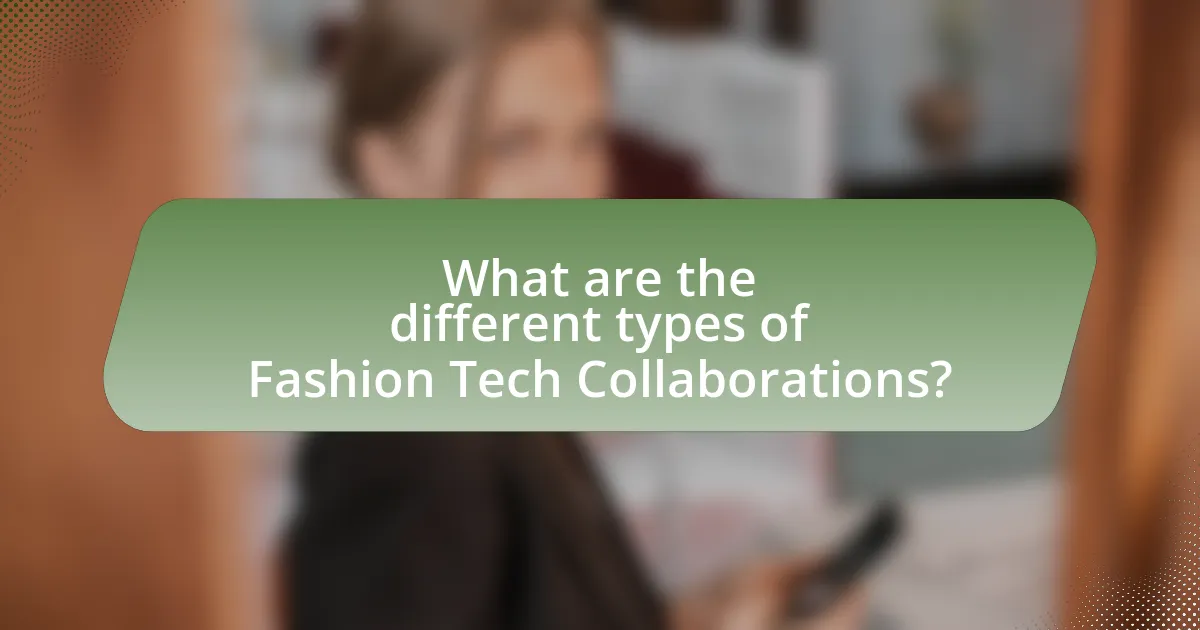
What are the different types of Fashion Tech Collaborations?
Fashion tech collaborations can be categorized into several types, including wearable technology partnerships, smart textiles development, augmented reality experiences, and e-commerce innovations. Wearable technology partnerships involve brands collaborating with tech companies to create devices like smartwatches or fitness trackers that integrate fashion with functionality. Smart textiles development focuses on creating fabrics that can monitor health metrics or change properties based on environmental conditions. Augmented reality experiences enhance customer engagement by allowing virtual try-ons or interactive shopping experiences through apps. E-commerce innovations involve collaborations that improve online shopping experiences, such as AI-driven personalization or virtual fitting rooms. These collaborations are increasingly prevalent as the fashion industry seeks to integrate technology to enhance consumer experience and product functionality.
How do collaborations between fashion designers and tech companies work?
Collaborations between fashion designers and tech companies typically involve the integration of innovative technology into fashion products, enhancing functionality and user experience. These partnerships often result in the development of smart textiles, wearable technology, and fashion apps that combine aesthetics with advanced features. For instance, the collaboration between Nike and Apple led to the creation of the Nike+ system, which integrates fitness tracking into athletic wear. Such collaborations leverage the strengths of both industries, with fashion designers focusing on style and tech companies providing technological expertise, ultimately leading to products that appeal to consumers seeking both fashion and functionality.
What are some notable examples of these collaborations?
Notable examples of fashion tech collaborations include the partnership between Nike and Apple, which resulted in the Nike+iPod Sports Kit, integrating fitness tracking with footwear. Another significant collaboration is between Google and Levi’s, leading to the development of the Jacquard jacket, which allows users to control their devices through touch-sensitive fabric. Additionally, the collaboration between Ralph Lauren and IBM produced a smart polo shirt that monitors biometric data during athletic activities. These collaborations exemplify the merging of style with functionality in the fashion tech industry.
How do these partnerships impact product innovation?
Partnerships in fashion tech collaborations significantly enhance product innovation by combining diverse expertise and resources. These collaborations enable brands to integrate advanced technologies, such as wearable tech and smart fabrics, into their designs, resulting in innovative products that meet evolving consumer demands. For instance, the partnership between Nike and Apple led to the development of the Nike+ system, which revolutionized how consumers track fitness through technology embedded in apparel and footwear. This synergy not only accelerates the design process but also fosters creativity, leading to unique solutions that blend style with functionality.
What role do wearable technologies play in Fashion Tech Collaborations?
Wearable technologies serve as a crucial bridge between fashion and functionality in Fashion Tech Collaborations. These technologies integrate advanced features such as health monitoring, connectivity, and interactive capabilities into clothing and accessories, enhancing user experience while maintaining aesthetic appeal. For instance, brands like Fitbit and Apple have collaborated with fashion designers to create stylish wearables that do not compromise on design, demonstrating that technology can be seamlessly incorporated into everyday fashion. This integration not only attracts tech-savvy consumers but also expands the market reach of fashion brands, as evidenced by the growing trend of smart textiles and connected apparel in recent years.
What are the most popular wearable technologies in fashion?
The most popular wearable technologies in fashion include smartwatches, fitness trackers, smart clothing, and augmented reality glasses. Smartwatches, such as the Apple Watch and Samsung Galaxy Watch, integrate health monitoring and communication features, making them highly sought after. Fitness trackers like Fitbit and Garmin focus on activity tracking and health metrics, appealing to health-conscious consumers. Smart clothing, exemplified by brands like Under Armour and Athos, incorporates sensors to monitor performance and biometrics. Augmented reality glasses, such as Google Glass and Snapchat Spectacles, offer interactive experiences that blend digital content with the physical world. These technologies are increasingly adopted due to their ability to enhance lifestyle and provide functionality while maintaining a fashionable appeal.
How do wearables enhance user experience in fashion?
Wearables enhance user experience in fashion by integrating technology with clothing and accessories, allowing for personalized and interactive experiences. For instance, smartwatches and fitness trackers provide real-time health data, enabling users to monitor their fitness levels while maintaining a stylish appearance. Additionally, smart fabrics can change color or pattern based on user preferences or environmental conditions, offering a unique way to express personal style. Research indicates that 70% of consumers are interested in wearable technology that combines fashion with functionality, highlighting the growing demand for such innovations in the fashion industry.
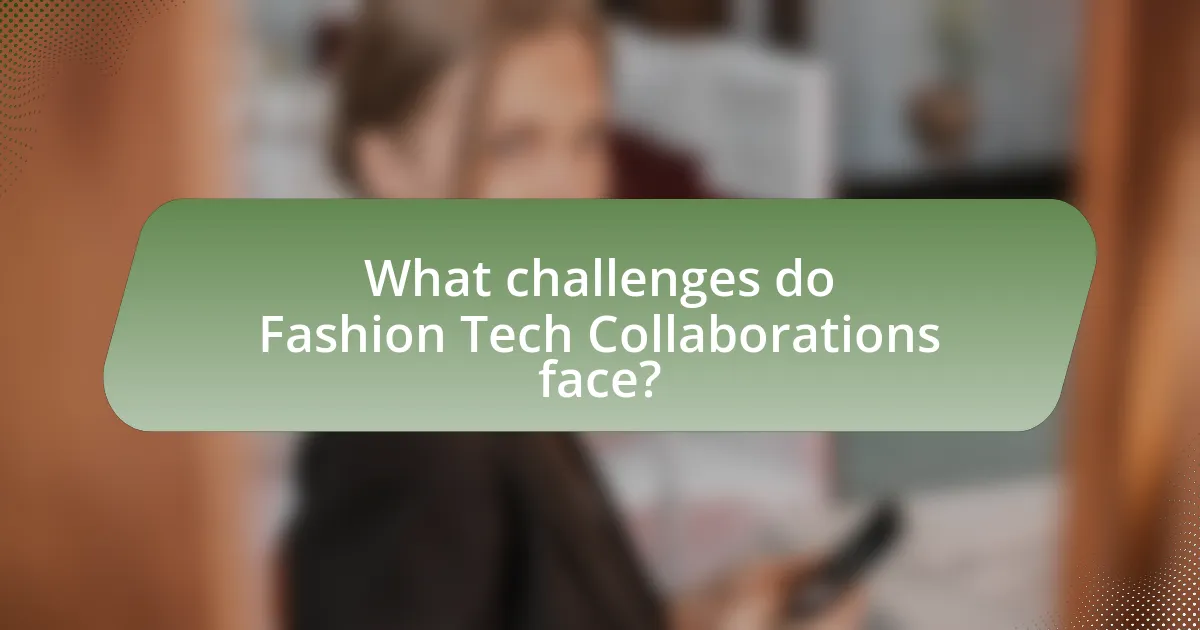
What challenges do Fashion Tech Collaborations face?
Fashion tech collaborations face several challenges, including technological integration, differing industry cultures, and consumer acceptance. Technological integration can be complex, as fashion brands often lack the technical expertise required to implement advanced technologies effectively. Differing industry cultures create friction, as fashion prioritizes aesthetics while tech focuses on functionality, leading to potential misalignment in project goals. Consumer acceptance is another hurdle, as customers may be hesitant to adopt new tech-infused fashion products, particularly if they perceive them as impractical or overly complex. These challenges can hinder the successful merging of style and functionality in fashion tech collaborations.
How do cultural differences affect collaborations?
Cultural differences significantly affect collaborations by influencing communication styles, decision-making processes, and conflict resolution approaches. For instance, in a collaborative environment, individuals from collectivist cultures may prioritize group harmony and consensus, while those from individualistic cultures may emphasize personal achievement and direct communication. This divergence can lead to misunderstandings or conflicts if not managed properly. Research by Hofstede indicates that cultural dimensions, such as power distance and uncertainty avoidance, shape how teams interact and collaborate, impacting overall project outcomes. Therefore, recognizing and addressing these cultural differences is essential for successful collaboration in diverse teams.
What are the common pitfalls in these partnerships?
Common pitfalls in fashion tech partnerships include misalignment of goals, lack of clear communication, and insufficient understanding of each other’s industries. Misalignment of goals can lead to conflicting priorities, resulting in projects that do not meet the expectations of either party. Lack of clear communication often causes misunderstandings and delays, hindering collaboration. Insufficient understanding of each other’s industries can result in ineffective integration of technology and fashion, ultimately compromising the product’s appeal and functionality. These pitfalls can significantly impact the success of collaborations, as evidenced by various case studies where partnerships failed to deliver due to these issues.
How can brands overcome these challenges?
Brands can overcome challenges in fashion tech collaborations by fostering strong partnerships with technology companies to enhance product innovation. Collaborative efforts can lead to the development of smart textiles and wearable technology that seamlessly integrate style and functionality. For instance, brands like Nike and Apple have successfully merged athletic wear with technology, resulting in products like the Apple Watch Nike+, which tracks fitness while maintaining aesthetic appeal. This approach not only addresses consumer demand for multifunctional products but also leverages technological advancements to stay competitive in the market.
What future trends can we expect in Fashion Tech Collaborations?
Future trends in Fashion Tech Collaborations will increasingly focus on sustainability, personalization, and the integration of advanced technologies such as artificial intelligence and augmented reality. Brands are expected to prioritize eco-friendly materials and processes, responding to consumer demand for sustainable fashion. Personalization will be enhanced through AI-driven data analytics, allowing brands to tailor products to individual preferences. Additionally, augmented reality will facilitate virtual try-ons, improving the shopping experience. These trends are supported by a growing market for sustainable fashion, projected to reach $8.25 billion by 2023, and the increasing adoption of AI in retail, which is expected to grow at a CAGR of 35% from 2021 to 2028.
How will advancements in technology shape future collaborations?
Advancements in technology will significantly shape future collaborations in the fashion tech sector by enabling seamless integration of digital tools and innovative materials. For instance, the use of augmented reality (AR) and virtual reality (VR) allows designers and consumers to interact with products in immersive environments, enhancing the collaborative design process. Additionally, advancements in artificial intelligence (AI) facilitate data-driven insights, enabling brands to tailor their offerings based on consumer preferences and trends. According to a report by McKinsey & Company, the fashion industry is projected to see a 20% increase in efficiency through the adoption of AI technologies by 2025, underscoring the transformative impact of technology on collaborative efforts in fashion.
What emerging markets are likely to influence these partnerships?
India and Southeast Asia are emerging markets likely to influence fashion tech partnerships. India, with its rapidly growing middle class and increasing internet penetration, is becoming a significant player in the fashion tech space, evidenced by a projected growth rate of 30% in the online fashion market by 2025. Southeast Asia, particularly countries like Indonesia and Vietnam, is experiencing a surge in e-commerce and mobile shopping, with a 50% increase in online fashion sales reported in 2022. These markets present opportunities for collaborations that blend technology with fashion, driven by consumer demand for innovative and convenient shopping experiences.
What best practices should brands follow in Fashion Tech Collaborations?
Brands should prioritize clear communication and alignment of goals in Fashion Tech collaborations. Establishing a shared vision ensures that both fashion and technology elements complement each other effectively. Additionally, brands should leverage data analytics to understand consumer preferences, which can guide product development and marketing strategies. Collaborating with tech experts can enhance innovation, while maintaining brand identity is crucial to resonate with target audiences. Successful partnerships often involve iterative testing and feedback loops, allowing for adjustments based on real-world performance and consumer response. These practices are supported by case studies showing that brands like Nike and Apple have thrived by integrating technology seamlessly into their offerings, resulting in increased customer engagement and satisfaction.
How can brands effectively communicate their collaboration goals?
Brands can effectively communicate their collaboration goals by establishing clear messaging that outlines the purpose, benefits, and expected outcomes of the partnership. This clarity ensures that all stakeholders, including consumers, understand the value proposition of the collaboration. For instance, when Nike and Apple collaborated on the Nike+iPod Sports Kit, both brands articulated their shared goal of enhancing athletic performance through technology, which resonated with their target audiences. This approach not only aligned their brand identities but also created a cohesive narrative that highlighted the innovative aspects of their partnership.
What strategies can enhance the success of these partnerships?
Effective communication and alignment of goals are essential strategies that can enhance the success of fashion tech partnerships. Clear communication ensures that all parties understand their roles, expectations, and the project’s vision, which fosters collaboration. Aligning goals helps partners work towards a common objective, increasing the likelihood of achieving desired outcomes. Research indicates that partnerships with well-defined objectives and open lines of communication are 30% more likely to succeed, as evidenced by case studies in the fashion industry where successful collaborations have led to innovative product launches and increased market share.
